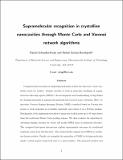Supramolecular Recognition in Crystalline Nanocavities through Monte Carlo and Voronoi Network Algorithms
Author(s)
Schwalbe-Koda, Daniel; Gómez-Bombarelli, Rafael
DownloadSubmitted version (2.655Mb)
Open Access Policy
Open Access Policy
Creative Commons Attribution-Noncommercial-Share Alike
Terms of use
Metadata
Show full item recordAbstract
© 2020 American Chemical Society. All rights reserved. Computational screening of templating molecules enables the discovery of new synthesis routes for zeolites. Despite decades of work in molecular modeling of organic structure-directing agents (OSDAs), the development and benchmarking of algorithms for docking molecules in nanoporous materials has received scarce attention. Here, we introduce Voronoi Organic-Inorganic Docker (VOID), a method based on Voronoi diagrams to dock molecules in crystalline materials, and release it as a Python package. Benchmarks of the implementation show that it generates docked poses up to 95 times faster than the traditional Monte Carlo docking scheme. We then evaluate the algorithm by obtaining binding energies for about 120 zeolite-OSDA pairs of industrial relevance. The computed host-guest interactions qualitatively explain experimental outcomes for traditional synthesis routes from the literature. The results further suggest new OSDAs to synthesize known zeolites. Finally, we exemplify the generality of VOID by docking molecules inside a metal-organic framework and on a metal surface. The proposed method and software provide a low-cost computational approach for generating molecule-material interfaces.
Date issued
2021Department
Massachusetts Institute of Technology. Department of Materials Science and EngineeringJournal
Journal of Physical Chemistry C
Publisher
American Chemical Society (ACS)
Citation
Schwalbe-Koda, Daniel and Gómez-Bombarelli, Rafael. 2021. "Supramolecular Recognition in Crystalline Nanocavities through Monte Carlo and Voronoi Network Algorithms." Journal of Physical Chemistry C, 125 (5).
Version: Original manuscript